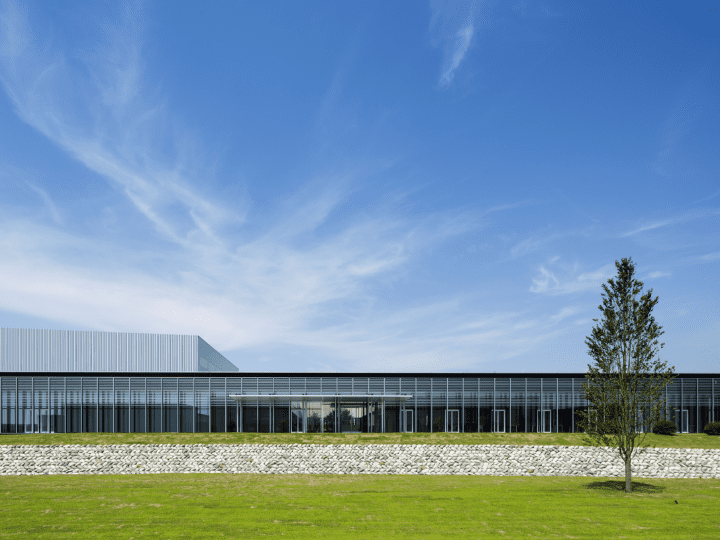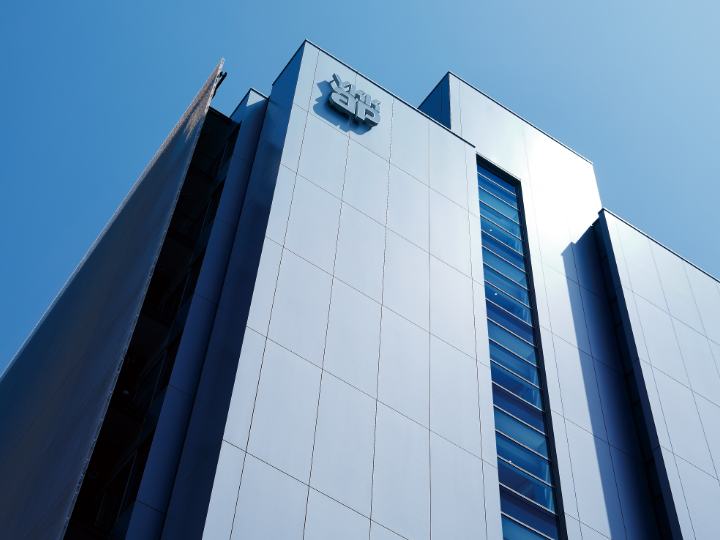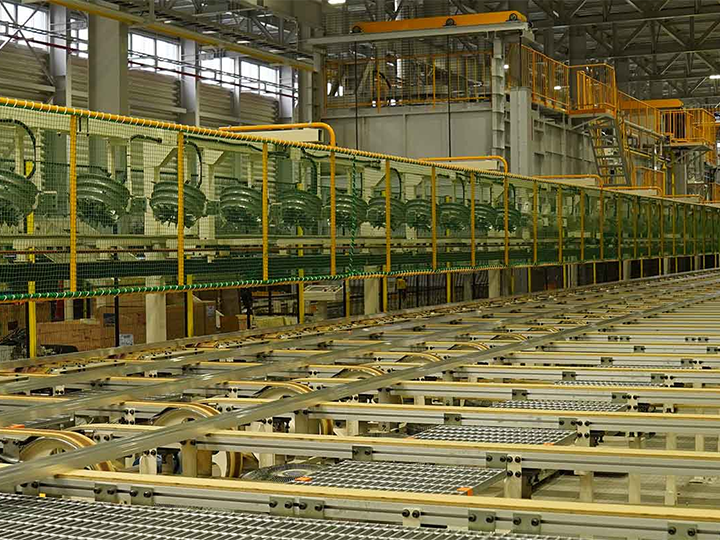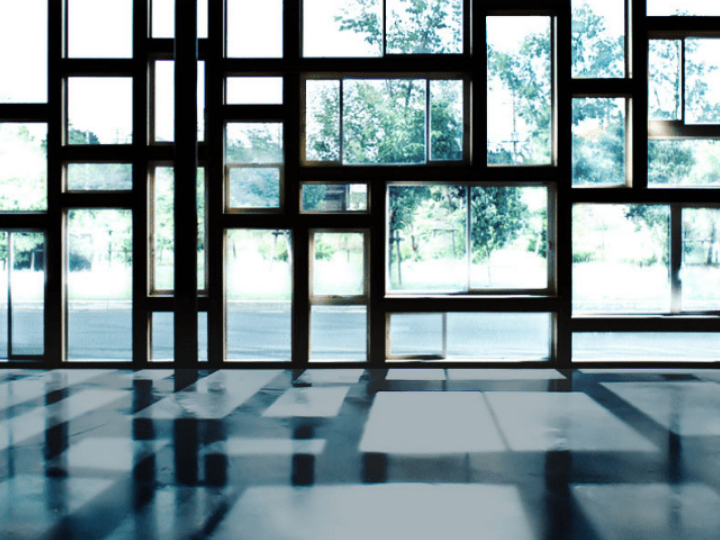
YKK AP breeds endangered medaka fish to support environmental education that promotes connections between monozukuri and local communities
"We Build a Better Society Through Architectural Products." This is YKK AP’s Purpose and the meaning of our existence as we conduct our business of developing, manufacturing, and selling windows, doors, and other items. The Kyushu Plant (in Yatsushiro City, Kumamoto Prefecture) started its Oshiete! Medaka-Sensei Project in 2010 to support environmental education.
In 1975, the Kyushu Plant started operating as a site for the integrated production of aluminum. It delivers high-quality products across the country by manufacturing industrial aluminum profiles as well as exterior products, including sashes, gates, and fences for residential and commercial buildings. The Environmental Facility Management Office supports this monozukuri by safely and reliably supplying the utilities needed to operate the plant, namely steam, electricity, and water. It is also in charge of building maintenance and environmental management. The office’s other important role is to promote connections with the local community, which involves environmental education for the next generation and activities contributing to the local region. Takashi Yoshioka (head of the Environmental Facility Line, Environmental Facility Management Office) spoke about these efforts.

A lushly green plant in a waterfront industrial zone
The Kyushu Plant, situated on the Yatsushiro Sea, has six buildings, including the Aluminum Casting Plant. Greenery covers one-fourth of the property. From the beginning our goal was for the Kyushu Plant to resemble a park, and we’ve planted different types of trees to greenify the site. There is a large, circular pond. The Environmental Facility Management Office is in charge of this zone, named "Water Park," with an area of approximately 10,000 square meters. The pond holds plant wastewater, including from aluminum surface treatment, so we can monitor its quality before releasing it into the ocean. Wild birds also live in Water Park, and the pond is home to ducks, carp, and other living creatures that we raise.
Water Park

Feeding the carp in the pond

The Oshiete! Medaka-Sensei Project began with a misunderstanding
In 2010, an Environmental Facility Management Office member had a child in elementary school. Their teacher said they could not obtain any wild medaka (also called "Japanese rice fish") for a classroom observation project. Our employee promised, "We’ve got lots of medaka in our Water Park. I’ll bring you some!" But when they presented the teacher with the fish they caught, they were astounded to learn that the fish were not medaka–they were mosquitofish, a non-native species. The employee was shocked! To fulfill his promise, he asked other office members to split up and search the area near the plant. They were able to find genuine medaka fish, which have been designated as an endangered species. The teacher was thrilled to receive them. That was the beginning of the Environmental Facility Management Office’s Oshiete! Medaka-Sensei Project, aimed at supporting environmental education for the next generation.

Environmental communication for children who will create the future
In 2010, YKK AP was working to provide environmental information and promote social activities according to its Environmental Policy, "Striving to build a sustainable society." The Kyushu Plant was exploring environmental communication methods in the manufacturing field, such as ways to tell the local community about how the plant was working to carry out environmentally friendly manufacturing. That’s when we started interacting with elementary schools. The Environmental Facility Management Office came up with a plan to carry out environmental communication about water, an environmental issue, through the topic of medaka. This would convey the office’s efforts to reduce water intake in the aluminum product manufacturing process, recycle water, and reduce the environmental impacts of wastewater. We started breeding medaka so we could continue bringing these fish to elementary schools. At first the fish were kept in an indoor aquarium, but it was difficult to regulate the water temperature and their eggs didn’t hatch. We switched to a creek on the premises, where the water temperature rises when the weather turns warm in early spring. The fish hatched, and we’ve raised them successfully ever since.

Creek where the medaka live
We also donate medaka to elementary schools in Yatsushiro City as part of our efforts to support environmental education. We initially approached the schools to tell them about this initiative. Now, we receive requests every year due to word of mouth among teachers, and the employees who reach out to their children’s elementary schools. While carrying out this project annually since 2010, we have donated 1,800 medaka fish to a cumulative total of 37 schools in the past 14 years (as of July 2023).

Donating medaka to an elementary school
Classroom visits by “Medaka-Sensei”
As we continued donating fish, people started to ask us, "Why is a window manufacturer breeding medaka?" That’s why we began visiting classrooms to introduce the plant’s environmental activities, including how we started raising these fish. At first the Environmental Facility Management Office members were unsure about taking on the unfamiliar role of teacher, but children actively participated in these classes and shared their unique viewpoints. They told us, "We want to protect the beautiful natural world where medaka live." We’ve completed 19 classroom visits so far (as of July 2023).

Classroom visit at Yatsushiro Municipal Sencho Elementary School in May 2023

After starting the Oshiete! Medaka-Sensei Project, an earthquake struck Kumamoto in 2016, causing damage to some of our flooring. We created a plan using leftover concrete from the repairs to build a new creek for breeding medaka. Office members used shovels to dig a ditch in a vacant spot on the plant premises, then poured concrete to create a creek with a length of 30 meters and a depth between 15 and 30 centimeters. The members take care of this creek every day and raise many medaka fish that are given to elementary schools.

An Environmental Facility Management Office member taking care of the medaka breeding pond
Local contribution activities for co-existence with the regional community
In addition to the medaka project, the Kyushu Plant does other types of local contribution activities as well. Every year, kindergarten students are invited to pick sweet potatoes from the field at the employee dormitory near the plant. We distribute tree seedlings grown at the plant to local residents and install nets on elementary school balconies to promote "green curtains." We also take part in environmental protection activities led by the Kumamoto Prefecture Environmental Preservation Assembly, including rice planting in June and harvesting in October.
At the Kyushu Plant, Environmental Facility Management Office members raise goats as an eco-friendly way to mow our lawns. They are also lent to daycare centers in Yatsushiro City as therapy animals.

Students from a local Yatsushiro City daycare harvesting sweet potatoes

Yoshioka feeding a goat
Building a better society by connecting people, the natural environment, and the future
YKK AP’s vision for 2050 is to "achieve zero environmental burdens through the entire lifecycles within its business activities." We are working to reduce our environmental impacts so we can create environmental value at all stages of these lifecycles. It’s important to think seriously about coexisting with the local community and natural environment, not just efforts inside the company. By communicating with local residents and society, our goal is to continually be a company that is trusted by the community and loved by society.
This is our 14th year implementing the Oshiete! Medaka-Sensei Project, which was the Kyushu Plant’s first environmental education support activity. A child who attended an elementary school that received medaka in the early years of the project has started working at the plant in the Environmental Facility Management Office, where they help breed these fish. I want to cherish these connections as we work to contribute to society through our business to help preserve the global environment for the future.

Members of the Kyushu Plant’s Environmental Facility Management Office

Takashi Yoshioka
Started working at YKK AP in 1992. Has been consistently involved in environmental facility management since he was assigned to the Environmental Engineering Group. His work spans a broad range of tasks including wastewater processing and monitoring, utility supply, activities to reduce environmental impacts, and regional contribution. Born in Yatsushiro City.
Share this article
- SNS Link X X Share
- SNS Link Facebook Facebook Share
- SNS Link LinkedIn LinkedIn Share
- SNS Link LINE LINE Share
- Copy Link Copy Link Copy Link Copied Link
Related stories
-

The Evolution of the Aluminum Profile Department into the Automotive Industry’s Manufacturer of Choice
- Aluminum Profile
- Technology
- Sustainability
- Solving Social Issues
-

Toward Achieving Carbon Neutrality: Taking on the Challenge of 100% Aluminum Recycling by a Window Manufacturer
- Technology
- Manufacturing
- Environment
- Sustainability
-

Stop the Landfill Disposal of Used Vinyl Windows! Disseminating Vision for Vinyl Window Recycling Through Industry-Government-Academia Collaboration, and Taking on the Challenge of "Window-to-Window" Recycling
- Technology
- Manufacturing
- Environment
- Solving Social Issues








